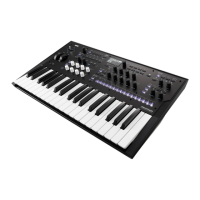Using the Librarian
9
Using the Librarian
Import and export
Import and export let you transfer data between the wavestate and the computer. is lets you import new sounds,
transfer sounds from one wavestate to another, or back up and restore specic data. (For backing up the entire contents
of the wavestate, see “Backup and restore” on page 10.)
Important: make sure to read “ink of the Editor/Librarian as an external display for the wavestate” on
page1.
Importing data
To import data from your computer to the wavestate:
1. In the File menu, select the Import… command.
A standard le open dialog will appear.
2. Select the wavestate le(s) to import.
You can select and import multiple les at once.
3. Press the Open button.
e data in the le(s) will be imported into the wavestate. A message will appear to conrm the import, including
information about which les have been added.
Data conicts
If some of the imported data appears to be dierent or updated versions of the internal data, a dialog will appear with
the text:
“A dierent or changed item already exists in the database for <item name>”
e dialog oers several options:
Cancel: the item will not be imported.
Overwrite: the item will be imported, replacing the version in the wavestate.
Make Unique: the item will be imported, and its UUID (see “UUIDs” on page9) will be changed so that it does not
conict with the version already in the wavestate.
Apply to All: the choice of Cancel, Overwrite, and Make Unique will be applied to all conicting les in the Import.
If a Set List is imported, and some of its constituent Performances were made unique, then the Set List is edited to point
to the new Performances.
UUIDs
e wavestate uses a database to keep sounds organized. Internally, sounds are identied not by their names, but rather
by a unique tag attached to the le, called a UUID (“Universally Unique Identier”). is means that even if a sound’s
name has been changed, the system still knows it’s the same sound.
When you write a sound from the wavestate front panel, “Overwrite” keeps the UUID the same, and “Save As New”
creates a new UUID.
When you import data, the UUIDs in the sounds to be imported are compared with those already in the database. If
a sound has the same UUID, but its contents are dierent, you’ll see the dialog described under “Data conicts” on
page9.
Exporting data
When exporting two or more pieces of data, you can either save them as separate les or as a single Bundle le.
Exporting as separate les
To export data from the wavestate to your computer as separate les on disk:
1. In the Main Window, select the data that you’d like to export.
For more information, see “List and selection” on page14.
2. In the File menu, select the Export… command.
A standard le open dialog will appear.
3. Navigate to the location to save the les.

